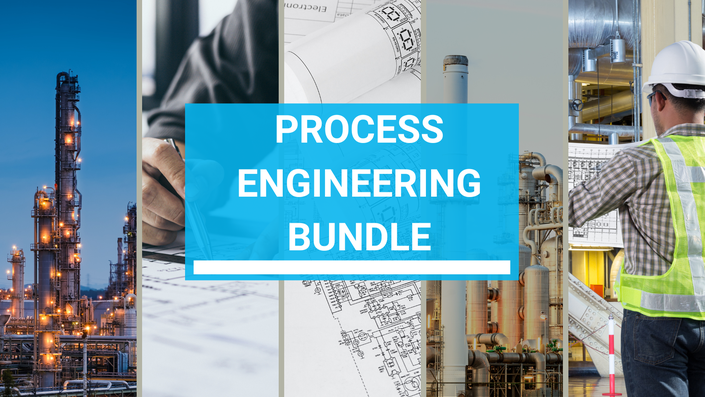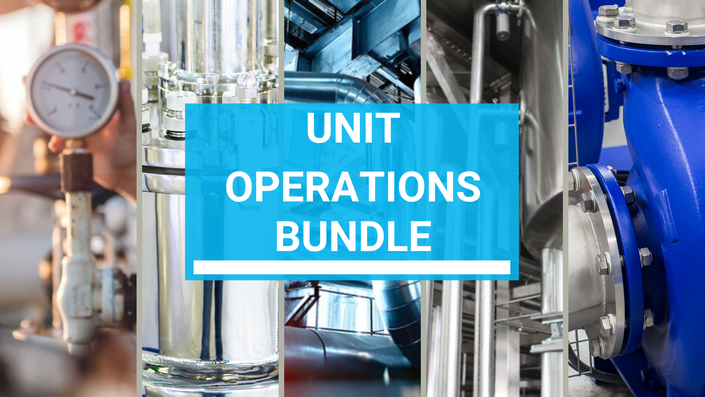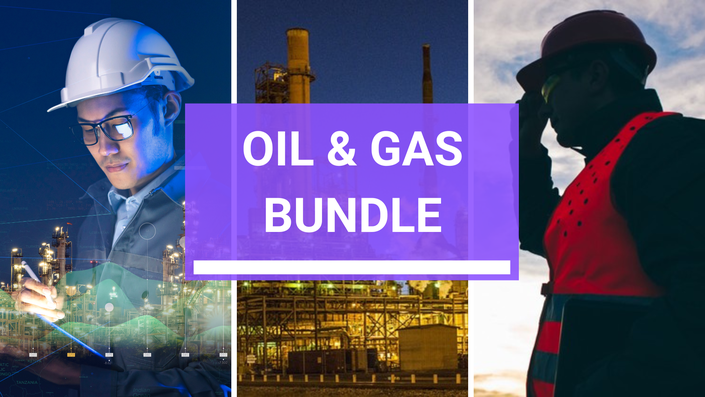Course Trailer
About this Course
📚 This Introduction to Mass Transfer Operations course introduces you to the essential principles of mass transfer and their applications in chemical engineering. You will explore key separation processes like absorption, distillation, and extraction, learning how to design efficient systems for industrial applications.
Key topics covered include:
- Fundamentals of Mass Transfer
- Diffusion and Fick's Law
- Vapor-Liquid and Liquid-Liquid Equilibrium
- Absorption, Distillation, and Extraction Operations
- Design of Mass Transfer Equipment (Columns, Contactors, etc.)
- Industrial Applications and Process Optimization
👨🏫 Designed for
Chemical engineering students, junior engineers, and professionals who are new to mass transfer operations and want to develop a solid foundation in separation processes for chemical plants.
📚 Course Approach
The course presents theoretical concepts paired with practical examples and case studies, ensuring that you can apply mass transfer principles to real-world process design and optimization.
🎯 By the end of the course, you will be able to:
- Understand the fundamental principles of mass transfer and diffusion
- Apply mass transfer principles to design and analyze key unit operations
- Evaluate separation processes like absorption, distillation, and extraction
- Design efficient mass transfer equipment and systems
- Optimize mass transfer operations for performance and energy efficiency
🚀 Recommended for
Students, early-career engineers, and professionals seeking to build a strong foundation in mass transfer operations and their applications in industrial chemical engineering systems.
✅ You’ll learn to:
- Apply Fick’s Law and diffusion principles to process design
- Analyze mass transfer in different separation processes
- Design mass transfer equipment such as absorption columns and distillation units
- Use process simulation tools to model and optimize mass transfer operations
- Evaluate the efficiency of mass transfer processes in industrial applications

Self-Paced, Dynamic Lectures
Learn at your own pace, anytime and anywhere.
The lectures are concise, engaging, and focused—designed to maximize your understanding efficiently.

Downloadable Material
Get access to all simulation files, workshop materials, spreadsheets, reference guides and companion E-Book.
Use them to practice offline, follow along with lessons, or revisit concepts anytime.

Evaluations, Quizzes
Evaluate your progress through interactive quizzes and self-assessments.
Reinforce key concepts, identify gaps, and ensure you're ready to apply what you've learned in real scenarios.

30 Day Money-Back Warranty
Enroll with confidence—if the course doesn’t meet your expectations, you can request a full refund within 30 days.
No questions asked.

Certificate of Completion
Receive an official certificate or diploma once you finish the course—perfect for showcasing your new skills on your resume, LinkedIn, or job applications.

Instructor Support
Get guidance whenever you need it—ask questions, request feedback, and interact directly with the instructor throughout the course.
Curriculum
- Welcome to the Course (2:22)
- Course Content (5:17)
- Objectives & Goals (4:52)
- Why this Course (4:24)
- How does a typical Mass Transfer Course looks like? (3:56)
- What is a Separation Process (3:21)
- What is a Mass Transfer Operation (2:37)
- Separation Process vs Mass Transfer Operation (1:36)
- Task - Separation Process vs Mass Transfer Operation (2:17)
- Separation vs Mixing vs Agitation (4:47)
- Reference Used (4:53)
- Some Notes (About this platform) (2:55)
- Contact Me (1:04)
- Join the Groups! (1:41)
- Reference Material
- Section 2 - Overview (1:58)
- Content of Section 2 (2:42)
- 2.1 History of Separation Technologies
- History of Separation Technologies (5:53)
- Task - Sea salt Production (0:55)
- Status Quo in the Separation Industry (1:42)
- Ore Extraction - Gold (1:31)
- Ore Extraction - Copper (2:23)
- Pharma (0:46)
- Task - Pharma (2:43)
- Air Separation via Distillation (1:37)
- Task - Air Separation (0:41)
- Perfume Production (1:27)
- Task - How Perfume is Made via Enfleurage (1:05)
- Water Waste Treatment (2:55)
- Coffee Separations - Drying, Leaching, Decaffeination (5:44)
- Task - Brew your own cup of coffee (2:25)
- Task - Identify Seapration Processes in the Kitchen (2:53)
- 2.2 MSA & ESA
- Why we need MSA & ESA (2:19)
- MAS vs ESA (5:55)
- 2.3 Classification types
- Mechanism of Separations (3:23)
- Classification of Processes (2:54)
- Classification I - Type of Method (3:47)
- Classification II - via Properties being Exploited (2:36)
- Classification III - via Separation Type (2:40)
- Classification IV - via Phases Involved (2:31)
- Separation by Phase Addition (2:01)
- Quick Overview of Classificaiton III - Separation Processes (1:50)
- Separation by Phase Creation (1:45)
- Separation by Barrier (2:01)
- Separation by Solid Agent (2:16)
- Separation by External Field or Gradient (1:20)
- Separations by Mechanical Physical Interaction (1:19)
- 2.4 Equilibrium vs. Rate Based Processes
- Equilibrium vs Rate Based Processes (5:34)
- Equilibrium Based Operations (8:56)
- Rate Based Operations (14:12)
- Summary - Rate Based Operations (2:25)
- Review - Equilibrium vs Rate Governed (1:13)
- Section 2 - Closure (1:13)
- Quiz - Section 2
- Section 3 - Overview (3:40)
- Content of Section 3 (1:44)
- Separation by Phase Addition & Creation Theory (7:47)
- 3.1 Distillation
- Flash Distillation (9:45)
- Fractional Distillation (17:22)
- Animation - McCabe Thiele Method for Methanol Water Separation (3:50)
- Batch Distillation (10:06)
- Animation - Multistage Batch Distillation (2:48)
- Steam Distillation (9:59)
- Vacuum Distillation (4:21)
- Pressure Swing Distillation (9:21)
- Introduction to Azeotropic Distillation (4:20)
- Azeotropic Distillation (10:29)
- Animation - Separating Binary Azeotropes using Pressure Swing Distillation (2:36)
- Extractive Distillation (8:44)
- Extractive vs Azeotropic Distillations (3:22)
- Case Study - Azeotropic vs Extractive Distillation (7:02)
- Reactive Distillation (6:24)
- Task - MTBE Process (0:47)
- 3.2 Gas absorption
- Task - Gas vs Vapor (0:29)
- Gas Absorption (12:57)
- Stripping (Desorbption) (10:08)
- Task - VOC Stripping (0:46)
- Reboiled Absorption (2:00)
- Refluxed Stripper (3:05)
- Reboiled Stripping (1:45)
- Task - Amine Treating Unit (1:33)
- 3.3 Liquid-Liquid Extraction
- Liquid Liquid Extraction (19:26)
- Several Operations involving Gas Liquid Operations (1:56)
- Animation - Construct Single Stage Liquid-Liquid Extraction (3:22)
- Section 3 - Closure (1:02)
- Quiz Section 3
- Section 4 - Overview (2:16)
- 4.1 Membrane Theory
- Membrane vs Filters (1:46)
- Animation - Membrane Concentration Profile (2:51)
- Animation - Membrane Separation of a Ternary Mixture (1:05)
- Introduction to Membranes (6:28)
- Membrane Shapes & configurations (2:39)
- More on Membranes (3:59)
- The Retentate & Permeate (3:17)
- Membrane Mechanisms (3:00)
- Advantages of Membrane Technologies (5:02)
- Disadvantages of Membranes (6:52)
- Membrane Classification (3:33)
- Membrane Materials (1:12)
- Membrane Properties (5:44)
- Concepts to study in Membrane Technology Course (1:35)
- 4.2 Industrial Processes
- List of Common Industrial Membrane Separation Process (2:14)
- Osmosis (4:08)
- Reverse Osmosis (14:33)
- Task - Revers Osmosis Plant (0:38)
- Dyalisis (7:40)
- Microfiltration (6:58)
- Ultrafiltration (5:26)
- Bonus - Nanofiltration (3:04)
- Gas Permeation (11:26)
- Pervaporation (8:15)
- Task - Perva-Tech (0:44)
- Liquid Membranes (12:24)
- Section 4 - Closure (1:10)
- Quiz Section 4
- Section 5 - Overview (2:27)
- Separation by Solid Agents
- 5.1 Adsorption Process
- An Overivew of Adsorption (4:01)
- Recovery of Solid Surfaces in Adsorption (7:17)
- Common Adsorbents used in the Industry (5:54)
- Physical Adsorption vs Chemisorption (4:20)
- Adsorption Equipment (13:00)
- Adsorption Process (3:04)
- 5.2 Ion Exchange
- Ion Exchange (6:37)
- Ion Exchange Equipment (2:09)
- Ion Exchange Processes (3:36)
- Task - Check out this Industry Ion Exchange (0:36)
- 5.3 Chromatography
- Chromatography - An Overview (13:26)
- Mechanisms of Chromatography (8:55)
- Chromatography Equipment (1:38)
- Chromatography Processes (2:04)
- Task - Industrial Chromatography (0:20)
- Animation - Liquid Chromatography Simulation (1:27)
- Animation - Analysis of Chromatographic Data (1:34)
- Section 5 - Closure (0:44)
- Quiz Section 5
- Section 6 - Overview (1:31)
- Content of Section 6
- Separation by External Fields (1:21)
- 6.1 Thermal Diffusion
- Thermal Diffusion (3:14)
- 6.2 Electrolysis
- Electrolysis (6:32)
- Task - Electrolysis in Chlor-Alkali (0:35)
- 6.3 Electrodialysis
- Electrodyalisis Overview (7:56)
- Equipment & Proceses involved in Electrodyalisis (2:05)
- Task - Electrodialysis (0:40)
- 6.4 Electrophoresis
- Electrophoresis (8:51)
- Section 6 - Closure (0:34)
- Quize Section 6
- Section 7 - Overview (3:02)
- Case Study - Sugar Production - Separation Processes involving Solids (13:21)
- 7.1 Leaching
- Leaching Overview (7:16)
- Leaching Operation (3:29)
- Leaching Processes (1:34)
- Task - Extracion involved in the Case Study of Sugra Production (0:27)
- Leaching Equipment (1:48)
- Animation - Countercurrent Leaching of Oil from Meal (1:21)
- 7.2 Washing
- Washing Overview (2:05)
- Thickeners used in Washing (4:35)
- Washing Hydroclone (2:35)
- Task - Leaching vs Washing (0:29)
- 7.3 Drying
- Drying - Overview (5:07)
- Drying Processes (1:29)
- Drying - Equipment (1:10)
- Task - Dryer Equipment (0:24)
- 7.4 Evaporation
- Overview of Evaporation in Mass Transfer (3:49)
- Type of Evaporators (3:24)
- Equipment used in Evaporation (1:17)
- Processes involving Evaporation (0:47)
- Task - Evaporaton Equipment (0:27)
- Animation - Multiple-Effect Evaporation of Sugar Solution (3:04)
- 7.5 Crystallization
- Crystallization - Overview of Process (4:54)
- Crystallization Equipment (5:05)
- Industrial Crystallization Processes (1:41)
- Animation - Evaporative Crystallization with Recycle (4:41)
- Section 7 - Closure (0:31)
- Quiz Section 7
- Section 8 - Overview (1:52)
- An Overview to Mechanical Physical Separations (2:45)
- Applications in Mechanical Physical Separations (1:55)
- Common Processes involving Mechanical Physical (6:19)
- Equipment used in Mechanical Physical Separations (4:03)
- Animation - Milk Centrifugation to Cream and Skim (1:43)
- Section 8 - Closure (1:13)
- Quiz Section 8
- Section 9 - Overview (2:03)
- 9.1 Separation Concepts
- An Overview of Concepts in Separation Technology (7:08)
- Introduction to Split Fraction and Split Ratio (7:28)
- Split Fraction (4:00)
- Split Ratio (3:10)
- Ex. Split Fraction & Split Ratio Calculations for a Hydrocarbon Process (18:35)
- Task - Split Ratio and Split Fraction Solved Exercises (1:37)
- Key Components (1:38)
- Product Recovery (2:49)
- Product Loss (2:53)
- Product Purity (3:10)
- Quick Summary on Product Purity vs Product Yield (1:25)
- 9.2 Separation Sequencing & Separation Factor
- Separation Sequencing (6:29)
- Heuristics & Thumb Rules in Sepration Sequencing (12:40)
- Separation Factor (SP) (7:23)
- Ex. Separation Factor Calculations for a Hydrocarbon Process (12:53)
- Separation Feasibility (10:09)
- Ex. Feasibility of Separation Methods in 5 Cases (13:56)
- Section 9 - Closure (0:45)
- Quiz Section 9
Course Enrollment
This and all other courses are available only via the All Courses - One Subscription Membership.

Hi, I’m Emmanuel Ortega,
a.k.a. the Chemical Engineering Guy!
With five years in the chemical industry, from petrochemical plant design to polyester textiles, I bring real-world experience to show the true value of engineering knowledge.
My Expertise:
- Process Simulation & Optimization
- Chemical Process Design
- Process Equipment Design
- Automotive & Industrial Polyester Yarn Technologies
- Online Tutoring, Online Education Management
The Courses I design are entirely dynamic. You will see theory and then apply it ASAP to a real life problem! I even use the books you are using right now in your engineering courses...
I'll see you in class!
Frequently Asked Questions (FAQ)
- When does the course start and finish?
- The course starts now and never ends! It is a completely self-paced online course - you decide when you start and when you finish.
- How long do I have access to the course?
- *How does lifetime access sound? After enrolling, you have unlimited access to this course for as long as you like - across any and all devices you own.
- NOTE*: This is true as long as you keep your subscription active.
- What if I am unhappy with the course?
- We would never want you to be unhappy! If you are unsatisfied with your purchase, contact us in the first 30 days and we will give you a full refund.
- Will I Get a Certificate/Diploma of Completion?
- Yes! After the course, you will get a Certificate of Completion with a Diploma! You can use this in your Resume!
- Are Resources Downloadable?
- Absolutely YES! Every resource is available for download, allowing you to study alongside them.
- Any doubt? Message me!
- Please reach out! [email protected]




